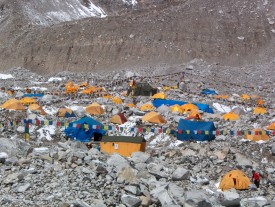RMI and Peak Freaks have arrived in Everest Base Camp in Nepal. The first of many.
It is critical to take your time getting to BC. Tim Rippel explains that two of his climbers are going lower, not higher, due to the impact of altitude. He does an excellent job of explain what is happening:
Unfortunately they have reached their wall and are not showing the ability to acclimatize at these elevations. It happens. It has nothing to do with fitness, it is entirely a haemoglobin thing. Also it should be noted that your chemical make up can also change at anytime. One trip you do well, the next not so well. One really can’t rely on previous experiences that much, most of the time you can- but not always. Today Pat Morrow (from the 1982) Canadian Everest expedition and Austrian climber Reinhold Messner both claim to suffer symptoms of AMS when returning to altitude. It’s a tricky thing. Remember it was Austrian Reinhold Messner that was the first to successfully climb Everest in 1976 without the use of supplementary oxygen.
Then there are people who break the rules of “going slow and only rising the recommended height per day“. Seems each year people either ignore these important recommendations or are misled. Last autumn we had to organize an Asian women who hired a local guide. The guide broke the rules- er beware!… Sometimes local guides hired off the streets in Kathmandu or Lukla don’t understand the importance of an acclimatization schedule or a member may insist that the job offer comes with a fast schedule.
In this case the member wanted to push higher faster and it came close to costing her her life. She was shutting down on the trail. Had we not intervened and organized to get her out, it is quite possible she would have passed away. Her pulse was 110 and her oxygen saturation level was 58%, she couldn’t stand and her eyes were rolling back. I organized a porter with a basket, put her in it and sent them down the trail immediately. It was late afternoon and they needed to drop elevation quickly and before dark. I found out later that she survived the night and eventually made it safely back to Kathmandu.
A few teams are still in Kathmandu, by design, and will miss the initial rush to the high camps. This is not a bad strategy in that steps are kicked into the route and all the “hot spots” are discovered. Well at least until the Icefall moves which can be 3 feet a day!
The fixed ropes for the South Col route is now in all the way to camp 1 in the Western Cwm but don’t look for teams to be there for a few days.
The first order of business for every team arriving at base camp is to get settled. This is a long expedition and there is no need to rush. They need to become further acclimatized to the altitude now they are living at 17,500′.
I know I always enjoyed a day or so just to get my tent arranged.
It sounds funny for a place the size of a king size bed but you generally have your duffels inside the tent, a sleeping pad or two as well as your sleeping bag. You might tie a small line around the top to hang a few items. You work the area around your tent to move a stone here and a rock there. Hey, it is home!
Next up for the teams already in BC is the Puja. The Sherpas will not touch the Icefall without an official Puja. And this requires a Lama to trek up from a village or in some cases, one of the Sherpas is a Lama and can perform the ceremony. But, it must be done before the first climber goes higher.
Climb On!
Alan




2 thoughts on “First Teams Arrive in BC”
Alan that is incredible about these two climbers. I pray my guides follow the rules and keep us in check.
Alan thank you for another excellent entry. Really enjoying your coverage so far. I remember years ago I drove from sea level to 14,000ft in a little over 1 hour (Mauna Kea – Hawaii). I can assure you this rapid elevation change made me feel very sick indeed!
Comments are closed.